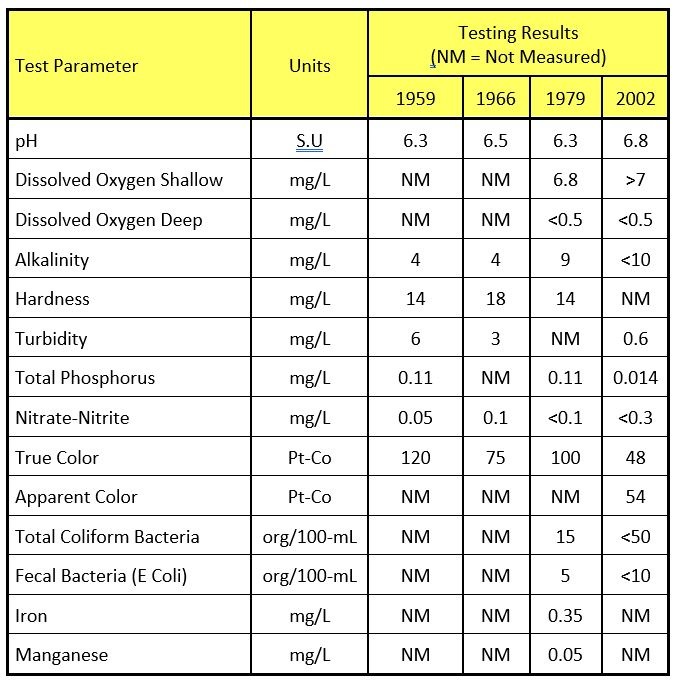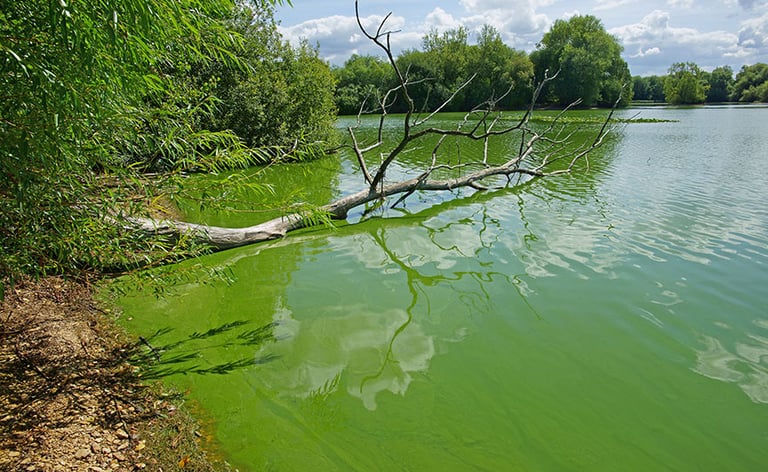Other Testing Data
While E. Coli testing is the most frequently performed analyses at Peters Pond, other tests are periodically conducted by PPGA and others.
General Water quality parameters
There are certain test/screening procedures that can be run to get an overall sense of the health of a lake - similar to a medical professional taking the temperature, blood pressure, and oxygen reading of a patient. These water screening procedures include pH, turbidity, dissolved oxygen, water temperatures, E. Coli bacteria, alkalinity, phosphorus, and nitrate.
The state of Massachusetts has in the past conducted limited testing in Peters Pond, on May 20, 1959, July 18, 1966, and June 28, 1979. Testing was also conducted on August 2, 2002 by ACT, a contractor retained by PPGA. These tests were run on a water sample obtained near the center of the pond (not the community beaches).
The testing results for these efforts are tabulated below, followed by an explanation of the results
pH -The pH measurement scale is from 0 to 14, where zero is extremely acidic, 7 is neutral, and 14 is the most basic. A pH range of about 5.5 -8.5 is desired for maintaining a healthy fishery. The values obtained at Peters Pond are very close to neutral and are considered acceptable.
Total Alkalinity-Alkalinity is a measure of the buffering capacity of a waterbody against acid additions such as acid rain and pollution, which can be detrimental to wildlife populations. Total alkalinity measures the presence of carbonates, bicarbonates and hydroxides and values below 20 mg/L are a signal that the pond may be susceptible to fluctuations in pH. The alkalinity at Peter's Pond has historically been less than 10 mg/L, which is not unusual for this region, but does show the pond may experience fluctuations in pH.
Turbidity- Turbidity is a relative measurement of the amount of suspended material in the water. It is measured through a process involving light diffraction of the sample as compared to a standard sample. Turbidity values can range from less than one to thousands of units, however, values in most ponds and lakes rarely rises above 5 NTU. While a value of 6 NTU was reported for the sample obtained in 1959, more recent samples have reported desirably low-level of suspended solids.
Total Phosphorus -Phosphorus is generally considered to be the limiting nutrient for plant and algae growth, with concentrations of 0.03 mg/L or more being sufficient to stimulate algae blooms or excessive plant growth. While elevated levels of phosphorus (0.11 mg/L) were recorded in 1959 and 1979, the value from 2003 was an order of magnitude lower, at 0.014 mg/L. Note, however, that low water column phosphorus does not necessarily relate to rooted plant growth, as these plants receive most of their nutrients from the bottom sediment.
Nitrate Nitrite -Nitrate-Nitrite is one of several forms of nitrogen in the water. Nitrate nitrogen is usually the most prevalent form of nitrogen in the water and results from such things as aerobic bacterial activity and fertilizer use. Nitrate-Nitrite concentrations have histoically been low in the pond.
True Color/ Apparent Color - Apparent color is the color of the unfiltered water that is caused by suspended and dissolved matter. True color is the color of filtered water due to dissolved constituents only, like tannic and humic acid. Color readings in Peters Pond has been historically been low to moderate, as the water is somewhat "tea colored".
Total and Fecal Coliform Bacteria- Coliform bacteria are naturally occurring in pond systems as well as resultant from human and animal inputs. A measure of just the fecal coliform bacteria is an indicator of the presence of human or animal waste inputs. In Massachusetts, acceptable values in "swimmable waters" is less than 235 organisms per 100 ml for fecal coliform (E. Coli) bacteria. While there have been episodes of high fecal bacteria at the community beaches on Peters Pond, levels in the middle of the pond have historically been low.
Temperature/Dissolved Oxygen/Water Clarity - A temperature/dissolved oxygen profile and water clarity (Secchi Disk transparency) was measured over the deepest part of the pond in 2003. The temperature ranged from 28°C at the surface to 20°C near the bottom. Dissolved oxygen was near the saturation point at the surface of the pond, but showed a continued decrease from 5 feet to the bottom, which is consistent with data from the 1979 study. This is fairly common in productive waterbodies, especially ones with significant amounts of organic sediments. The Secchi disk transparency at the time of the survey was measured at 7-feet, which is within a desirable range for a relatively shallow, productive pond.
Water Quality Summary- The overall water quality in the pond is good. Water column nutrients in recent tests were desirably lower as was the amount of suspended solids as measured with turbidity and color. Water quality parameters, especially phosphorus and other nutrients, can change over time, which is why PPGA will be conducting additional testing in 2022.


CYANOBACTERIA ("BLUE GREEN ALGAE")
Every year, certain beaches at Massachusetts and New Hampshire lakes are shut down due to an outbreak of Cyanobacteria, also known as "Blue Green Algae". In some cases, these blooms are quite noticeable by their bright-green coloration.
The good news: there has not been a recorded outbreak of Cyanobacteria blooms in Peters Pond in at least the last 30 years. The bad news: it could happen. Ironically, it may be the tea-coloration of the water or the thick growth of weeds that have helped prevent these outbreaks in Peters Pond. But we still need to be vigilant.


So what's the deal? First off, this stuff in not really algae, but a type of bacteria that can photosynthesize (like algae does). Also - it's everywhere, and its been around for billions of years. At low levels, it's not a problem. However, excessive amounts of nutrients (e.g., fertilizer) entering a water body can allow these organisms to reproduce like crazy and create blooms. And when the Cyanobacteria cells die, they can secrete toxic chemicals into the water ("cyanotoxins" like Microcystins). It is the cyanotoxins that can make people and animals sick, if they ingest enough water. And given that they tend to drink a whole lot more pond water than people, it is dogs that are most often poisoned by these outbreaks.
Not all cyanobacteria secrete cyanotoxins, but the presence of green water or other indication of a bloom should be avoided and considered guilty until proven innocent.
What is PPGA doing about this? We periodically screen the pond water for the presence of cyanobacteria using a portable instrument known as an In-Vivo Fluorescene (IVF) meter. If this screening indicates the presence of significant concentrations of cyanobacteria, samples will be examined under a microscope. If an outbreak of cyanobacteria is confirmed, samples of water at the beaches would be sampled and analyzed for the presence of cyanotoxins. And if need be, signs will be posted at the beaches warning of this problem, and further information will be posted on this web site.
Residents can help avoid these outbreaks by minimizing the use of fertilizers, and if you are on a septic system, by not using detergents containing phosphates - the same steps needed to minimize weed growth.
Note: this is NOT a photo of Peters Pond!